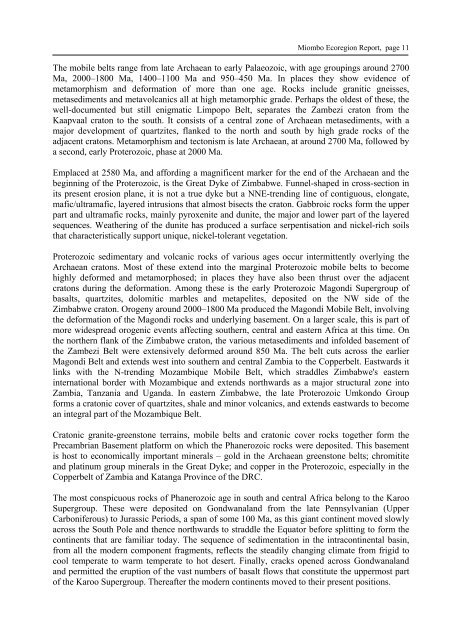Miombo Ecoregion Vision Report - Biodiversity Foundation for Africa
Miombo Ecoregion Vision Report - Biodiversity Foundation for Africa
Miombo Ecoregion Vision Report - Biodiversity Foundation for Africa
You also want an ePaper? Increase the reach of your titles
YUMPU automatically turns print PDFs into web optimized ePapers that Google loves.
<strong>Miombo</strong> <strong>Ecoregion</strong> <strong>Report</strong>, page 11<br />
The mobile belts range from late Archaean to early Palaeozoic, with age groupings around 2700<br />
Ma, 2000–1800 Ma, 1400–1100 Ma and 950–450 Ma. In places they show evidence of<br />
metamorphism and de<strong>for</strong>mation of more than one age. Rocks include granitic gneisses,<br />
metasediments and metavolcanics all at high metamorphic grade. Perhaps the oldest of these, the<br />
well-documented but still enigmatic Limpopo Belt, separates the Zambezi craton from the<br />
Kaapvaal craton to the south. It consists of a central zone of Archaean metasediments, with a<br />
major development of quartzites, flanked to the north and south by high grade rocks of the<br />
adjacent cratons. Metamorphism and tectonism is late Archaean, at around 2700 Ma, followed by<br />
a second, early Proterozoic, phase at 2000 Ma.<br />
Emplaced at 2580 Ma, and af<strong>for</strong>ding a magnificent marker <strong>for</strong> the end of the Archaean and the<br />
beginning of the Proterozoic, is the Great Dyke of Zimbabwe. Funnel-shaped in cross-section in<br />
its present erosion plane, it is not a true dyke but a NNE-trending line of contiguous, elongate,<br />
mafic/ultramafic, layered intrusions that almost bisects the craton. Gabbroic rocks <strong>for</strong>m the upper<br />
part and ultramafic rocks, mainly pyroxenite and dunite, the major and lower part of the layered<br />
sequences. Weathering of the dunite has produced a surface serpentisation and nickel-rich soils<br />
that characteristically support unique, nickel-tolerant vegetation.<br />
Proterozoic sedimentary and volcanic rocks of various ages occur intermittently overlying the<br />
Archaean cratons. Most of these extend into the marginal Proterozoic mobile belts to become<br />
highly de<strong>for</strong>med and metamorphosed; in places they have also been thrust over the adjacent<br />
cratons during the de<strong>for</strong>mation. Among these is the early Proterozoic Magondi Supergroup of<br />
basalts, quartzites, dolomitic marbles and metapelites, deposited on the NW side of the<br />
Zimbabwe craton. Orogeny around 2000–1800 Ma produced the Magondi Mobile Belt, involving<br />
the de<strong>for</strong>mation of the Magondi rocks and underlying basement. On a larger scale, this is part of<br />
more widespread orogenic events affecting southern, central and eastern <strong>Africa</strong> at this time. On<br />
the northern flank of the Zimbabwe craton, the various metasediments and infolded basement of<br />
the Zambezi Belt were extensively de<strong>for</strong>med around 850 Ma. The belt cuts across the earlier<br />
Magondi Belt and extends west into southern and central Zambia to the Copperbelt. Eastwards it<br />
links with the N-trending Mozambique Mobile Belt, which straddles Zimbabwe's eastern<br />
international border with Mozambique and extends northwards as a major structural zone into<br />
Zambia, Tanzania and Uganda. In eastern Zimbabwe, the late Proterozoic Umkondo Group<br />
<strong>for</strong>ms a cratonic cover of quartzites, shale and minor volcanics, and extends eastwards to become<br />
an integral part of the Mozambique Belt.<br />
Cratonic granite-greenstone terrains, mobile belts and cratonic cover rocks together <strong>for</strong>m the<br />
Precambrian Basement plat<strong>for</strong>m on which the Phanerozoic rocks were deposited. This basement<br />
is host to economically important minerals – gold in the Archaean greenstone belts; chromitite<br />
and platinum group minerals in the Great Dyke; and copper in the Proterozoic, especially in the<br />
Copperbelt of Zambia and Katanga Province of the DRC.<br />
The most conspicuous rocks of Phanerozoic age in south and central <strong>Africa</strong> belong to the Karoo<br />
Supergroup. These were deposited on Gondwanaland from the late Pennsylvanian (Upper<br />
Carboniferous) to Jurassic Periods, a span of some 100 Ma, as this giant continent moved slowly<br />
across the South Pole and thence northwards to straddle the Equator be<strong>for</strong>e splitting to <strong>for</strong>m the<br />
continents that are familiar today. The sequence of sedimentation in the intracontinental basin,<br />
from all the modern component fragments, reflects the steadily changing climate from frigid to<br />
cool temperate to warm temperate to hot desert. Finally, cracks opened across Gondwanaland<br />
and permitted the eruption of the vast numbers of basalt flows that constitute the uppermost part<br />
of the Karoo Supergroup. Thereafter the modern continents moved to their present positions.


